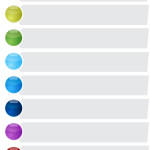Bullet-Point Blogging
“Bullet points, when used wisely, can increase readability and retention by readers,” Michael Bailey reminds us in Internet  Marketing: an Hour a Day. So is that all we need to know? Not by a long shot, because bullet points can very easily go very wrong.
Marketing: an Hour a Day. So is that all we need to know? Not by a long shot, because bullet points can very easily go very wrong.
Bullet points are mini-headlines, encouraging readers to go back into the real meat of your content or go forward with your call to action, says Robert Bruce of copyblogger.com. Bruce offers three bullet-point rules of thumb:
- Keep them symmetrical (1-line each, 2-lines each, etc.).
- Practice parallelism (begin each with the same part of speech).
- Keep them short for greater impact.
“When website visitors read text online, they do not want to work too hard at the task,” says writeraccess.com. Bullet points draw the readers’ eyes to the most important information. Writeraccess reminds blog content writers of some basic punctuation and grammar rules:
- The text used to introduce a section of bullet points should end in a colon.
- When the information is a complete sentence, begin with a capital letter and end with proper punctuation.
A “sneaky tip” offered by websitecopywritingservices.com is that the first and last items in a list generally grab the most attention, so use the start and end of the list to convey whatever is most important.
William Green, guest blogging on BloggerSentral.com, makes no bones about the way he feels about bullet points. “They benefit nearly every area of your blog, be it traffic, SEO, Twitter follows, RSS subscribers, I mean everything,” he says.
As a corporate blogging trainer, I particularly liked what Green had to say about finding the right balance between paragraphs and bullet points. If you can use both, he says, you will be become a successful blogger.

Leave a Reply
Want to join the discussion?Feel free to contribute!